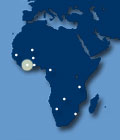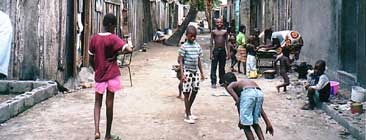|
||||||||||||
| Burkina Faso | Cameroon | Cote D’Ivoire | Ghana | Mali | Namibia | Senegal | Swaziland | Tanzania | Zambia | ||||||||||||
Information Source: Cote D'Ivoire: Country Assessment Report. |
||||||||||||
|
||||||||||||
|
Context Summary Côte d’Ivoire has an estimated population of 15 million and an annual population growth of 2.6 percent (2000 data). Its economy is primarily agricultural; the country is among the world’s largest producers and exporters of coffee, cocoa beans and palm oil. Until 1975, Côte d’Ivoire was the most prosperous of the sub-Saharan African countries due to its agricultural exports. Côte d’Ivoire has been in an economic recession since 1986 which led to a reduction in GNP per capita from US$1,000 in 1980 to US$670 in 2000. Côte d’Ivoire is now ranked 154th out of 174 counties listed in 2000, according to the Human Development Index (HDI). Extensive urban poverty is a recent phenomenon in Côte d’Ivoire; in 1992, it was estimated that 50 percent of the total population was living in poverty. The proportion of poor households rose from 11 percent in 1985 to 32.3 percent in 1993. The proportion of poor householders in Abidjan rose from 4.8 percent in 1993 to 20.1 percent in 1995.” Approximately 46 percent (6.9 million) of the total population of Côte d’Ivoire lives in urban areas. Yamoussoukro is the official capital; however, Abidjan is the de facto capital, the largest city, and the main port. In 1963, the population of Abidjan was 300,000; in 2000 it was estimated at almost three million, which represents 40 percent of the total urban population of the country. During the period of economic prosperity, the rate of population growth was very high because of immigration from neighboring African counties. In 1999, it was estimated that workers from neighboring countries comprised 20 percent of the population. In 1999, there was a military coup, and the country has recently been dealing with a political and economic instability that it had not experienced previously.
Lessons from Recent Projects - Summary (Lessons based on 1994 evaluation of Alliodan, M'Ponon, PK18, Ramblai I and Ramblai II and Zoe Bruno areas in Abidjan.) Conflict about the population surveys
Problems concerning how to evaluate the demand of infrastructure by the population and the costs of the upgrading
Inefficient methods of cost-recovery
Financial contribution of the population
Problems with the management of funds
Problems with the resettlement of displaced people
The role of the mayors and the Upgrading Support Committees
Clarification of the objectives of the land legalization and upgrading activities
For the other projects carried out in Abidjan some further lessons are noted. The approach for supporting local initiatives though MOS
Actors in the upgrading projects
The institutional MOS framework for the 'Under-Equipped Neighborhood Support Program'
The international institutions had agreed to pay for MOS
The Projet de Quartier approach
The physical development of the project.
|
||||||||||||
|
|
||||||||||||
| For more information: Click on: Foreword and Overview 1. Problems and Context 2. Current Situation 3. Policy Context and Institutional Framework 4. Upgrading Projects and Programs 5. Case Study 6. Lessons Learned 7. Challenges and Proposed Next Steps Annex A: Country and City Profiles Annex B: Bibliography Annex C: Contact Information Annex D: Photographs Download for Printing: |
||||||||||||
| < Return to top > | ||||||||||||
|
||||||||||||


